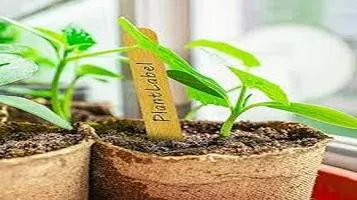Review about Plant Labels
Plant labels are essential tools for gardeners and horticulturists, providing a clear and organized way to identify and categorize plants in gardens, greenhouses, and nurseries. Typically made from durable materials like plastic, metal, or wood, these labels are designed to withstand various weather conditions while maintaining legibility. They often feature information such as the plant's common name, scientific name, planting date, and care instructions. By using plant labels, gardeners can easily track the growth and health of their plants, ensuring proper maintenance and care. Additionally, they aid in educational settings, allowing students and visitors to learn about different plant species and their characteristics. With their practicality and versatility, plant labels are indispensable for both amateur and professional gardening enthusiasts.

Types of Plant Labels
1. Plastic Plant Labels:
Plastic labels are among the most common and affordable options. They come in various shapes and sizes, such as T-shaped, stick tags, or hanging tags. While their affordability and ease of use are appealing, they do have some downsides. Over time, plastic labels can become brittle and break, especially when exposed to extreme weather conditions. Furthermore, the ink used to write on them can fade, making it difficult to read the labels after a season or two.
2. Wooden Plant Labels:
Wooden labels bring a rustic charm to the garden. They are usually made from bamboo or other sustainable wood sources. While they are biodegradable and eco-friendly, they also have a shorter lifespan than other materials. Wood can rot, mold, or be consumed by insects, and the writing on them can fade. However, for gardeners who prefer an organic look and are willing to replace them regularly, wooden labels are a beautiful option.
3. Metal Plant Labels:
Metal labels, made from aluminum, zinc, or stainless steel, offer durability and longevity. They are resistant to weather conditions and do not degrade over time. The information can be either engraved or written with a special marker. Engraving is permanent but can be more expensive. Metal labels are perfect for perennial plants and those that require long-term identification.
4. Slate and Stone Labels:
For a more decorative touch, slate or stone labels are excellent choices. They are durable, weather-resistant, and add a unique aesthetic to the garden. You can write on them with chalk or special markers. Though they might be more expensive and heavier, their longevity and beauty often justify the cost.
5. DIY Labels:
Creative gardeners often make their own labels using materials like wine corks, broken pottery, or recycled plastic containers. DIY labels, while not always as durable as commercial options, offer a personalized and eco-friendly approach to garden labeling.
Uses of Plant Labels
Plant labels are indispensable for various gardening activities:
1. Identification:
They help identify different plant species, especially in a garden with diverse flora. This is crucial for both novice and experienced gardeners to avoid confusion and ensure proper care.
2. Tracking Growth:
Labels can include information like planting dates, bloom times, and harvest dates. This helps in tracking the growth progress and making necessary adjustments in care routines.
3. Care Instructions:
Specific care instructions, such as water requirements, sunlight needs, and fertilization schedules, can be included on the labels. This is particularly useful when multiple people are tending the garden.
4. Educational Purposes:
In community gardens, botanical gardens, or school projects, plant labels serve educational purposes, providing information about plant species, their origin, and their uses.
Benefits of Using Plant Labels
1. Organization:
Plant labels bring order to a garden, preventing the mix-up of different plants and ensuring that each plant receives its specific care.
2. Efficiency:
They save time and effort by providing immediate information about the plant, reducing the need to remember or search for details.
3. Aesthetics:
Well-chosen labels can enhance the visual appeal of the garden, making it look well-maintained and professional.
4. Record Keeping:
They aid in maintaining records of plant varieties, especially for seed-saving purposes or when experimenting with new plant species.
Tips for Choosing the Right Plant Labels
1. Durability:
Consider the lifespan of the labels. For annual plants, temporary labels might suffice, while perennials and shrubs benefit from more durable options.
2. Weather Resistance:
Ensure the labels can withstand the local climate, including rain, sun, and wind. Materials like metal and slate are excellent for harsh weather conditions.
3. Visibility:
Choose labels that are easy to read from a distance. Bright colors or reflective materials can improve visibility.
4. Eco-Friendliness:
Opt for biodegradable or recyclable materials to minimize environmental impact.
5. Cost:
Balance cost with quality. While it might be tempting to go for cheaper options, investing in durable labels can save money in the long run.
In conclusion, plant labels are a vital tool for any gardener, enhancing organization, efficiency, and the overall gardening experience. By choosing the right type based on your specific needs and preferences, you can ensure that your garden remains well-maintained and beautiful for years to come.






